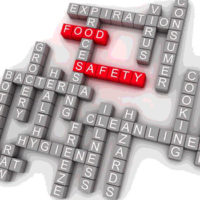Ice machines are not the first thing that people think about when they get sick after eating at a restaurant. They’ll think about the burrito, steak, or perhaps even the salad they had. The lonely ice machine stands in the cold. People assume it’s void of contamination. But is it really?
In reality, ice cubes make an excellent gathering place for bacteria to spread to people. The temperature inside of an ice machine isn’t cold enough to kill bacteria, resulting in many routes for possible contamination. This is because most people don’t think about how their actions could possibly infect the bin.
Think about it: where there’s water, bacteria gather and find a way to survive. Surely there are more obvious places to check for bacteria like cutting boards or food storage facilities, but it’s very easy for bacteria to infect ice. This is one reason why ice is officially classified as a food, according to the U.S. Food and Drug Administration (FDA).[1]
Even if we washed our hands before and after using the ice scoop, there’s a chance that airborne bacteria riding on dust can find a home and develop a colony. That’s why frequent sanitizing is so important. But how do you know if your ice bin might have been contaminated?
- The bin gives off a foul odor
- Ice looks, tastes, or smells strange[2]
- Walls, lid or seals show discoloration
If you’re noticing any of these signs––or if customers make remarks about the flavor of their drinks––it’s time for a good cleaning and sanitizing. But how often should cleaning and sanitizing be performed?
Ice bins should be cleaned at least monthly, preferably weekly. Scale removal should be done at least twice a year, or according to manufacturer’s specifications. Scales can be the starting point for bacteria.
The biggest signal that your ice bins and machines are developing bacteria is the formation of biofilm on the walls of your ice bin.[3] Biofilm is like a nest for bacteria. Most bacteria can create them. The slime on rocks in a river and the plaque on your teeth are examples of biofilms. These films are rather tough to eliminate the longer they’re allowed to develop. Trying to wipe biofilm off with a wet cloth is about as effective as trying to lick your teeth clean. If you can see slime or feel the walls getting slick on the inside of your machine, you’ve got biofilm. That’s the signal to take out the strong antimicrobial cleaners that are specifically designed for ice machines. The sanitizing products which are on the market are custom made to break up the film and kill off the bacteria. Once this is done, scrubbing with a cloth will lift off the accumulated mess.
In a heavily contaminated machine, biofilm can spread to components that are not so easy to clean. If the film started through scale attachment, that will have to be removed with a separate product. Tiny cracks and nooks could hold bacterial colonies that a brush or a cloth can’t easily reach. Some restaurants and other ice machine owners contract out their major cleaning to the pros because their tools and knowledge will help in seeking out those little nooks and crannies where bacteria like to hide.
The key to keeping bacterial contamination from getting to this point is proper ice handling and regular cleanings. It really is like brushing your teeth. If you brush your teeth every day, it’s easy. Let it go a week and you’ll be spending a while getting them back to clean. Similarly, if you sanitize your ice bin every week you’ll have a much lower chance of infection.
Fortunately, there are ways of sanitizing ice bins that don’t involve dumping all the ice each time. Many modern ice machines are fitted with an ultraviolet (UV) light inside of the bin. UV light is highly damaging to biofilms and to bacteria. While UV lamps do not reduce the need for sanitization they can reduce the frequency it needs to be done. Also, there are kits to retrofit older machines to use these lamps.
Another way to help is to get an ice machine with antimicrobial surfaces. These surfaces are designed to make it hard for bacteria to adhere and also contain elements that can kill bacteria upon contact. Ice machine makers are starting to incorporate these into their ice bins to further reduce the frequency of manual scrubbing.
The best machines currently need cleaning two to four times a year––about the same frequency as descaling. Yet even with technological advances, cleaning and sanitizing your ice machine cannot be ignored. In fact, the FDA requires that machines be cleaned per manufacturer directions or whenever contamination is seen. Don’t put it off or you might have to face an angry health inspector––or worse––a sick customer.
To learn more, visit IceMachinesPlus.com.
1. http://www.fda.gov/Food/ResourcesForYou/Consumers/ucm197586.htm.
2. http://www.foodrepublic.com/2013/04/09/why-does-some-ice-taste-bad.
3. https://www.biofilm.montana.edu/resources/images/multicellularextracellular/biofilm-formation-3-steps.html.




